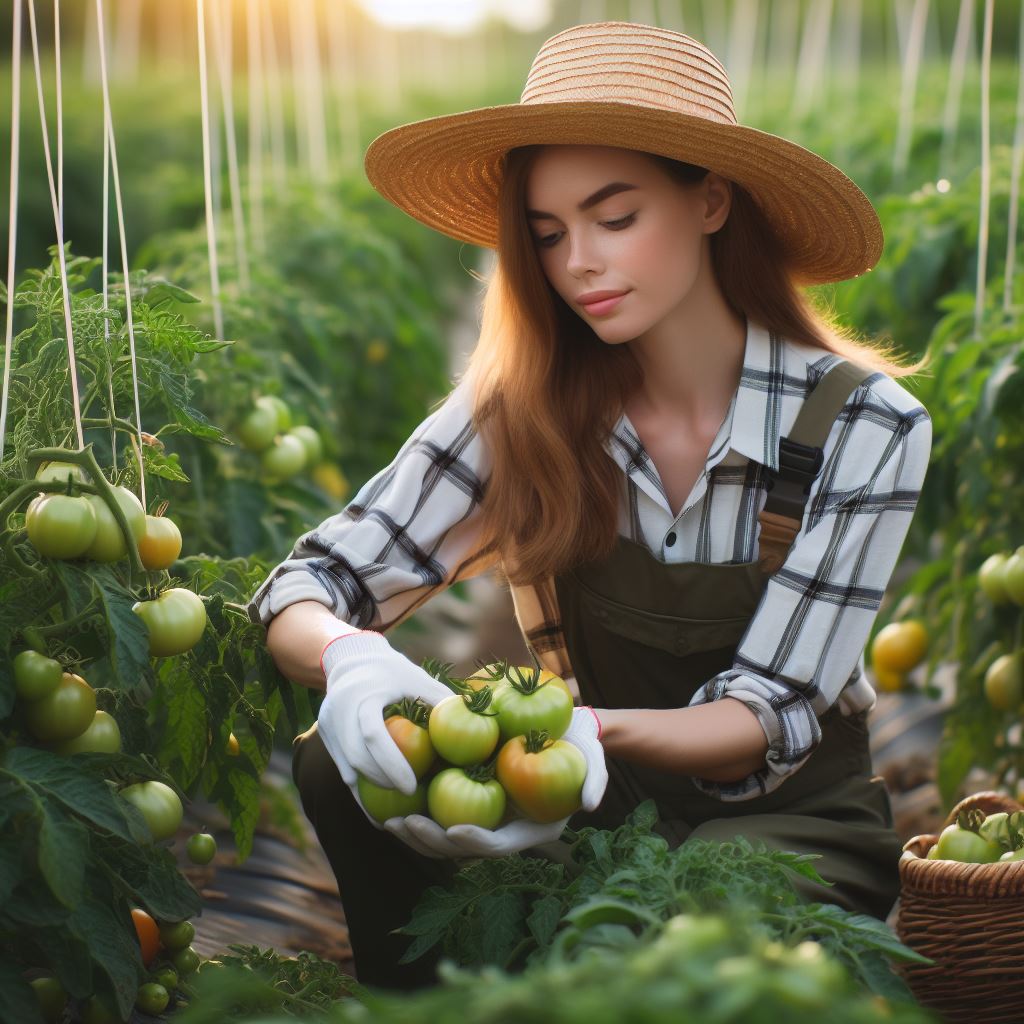Introduction
Let’s explore tomato cultivation: Tips for a healthy crop.
Tomato cultivation is a vital aspect of agriculture, as tomatoes are not only delicious but also packed with essential nutrients.
Growing tomatoes in your garden allows you to have a steady supply of fresh and flavorful produce throughout the growing season.
The goal of this blog post is to provide valuable tips and advice for cultivating healthy tomatoes.
Whether you are a beginner or an experienced gardener, these tips will help you ensure a successful tomato crop.
One important tip is to choose the right tomato varieties that are suited for your climate and growing conditions.
This will maximize your chances of a bountiful harvest.
Additionally, preparing the soil properly by adding organic matter and ensuring good drainage is vital for the healthy growth of tomato plants.
Watering is another crucial aspect of tomato cultivation.
Tomato plants require regular watering, especially during hot and dry periods.
To prevent diseases, it is important to water the plants at the base and avoid wetting the foliage.
Proper pruning and staking of tomato plants are also essential for their healthy growth.
Pruning helps in increasing air circulation, reducing the risk of diseases, and promoting better fruit production.
Staking provides support to the plants, preventing them from falling and breaking under the weight of the fruit.
Furthermore, regularly monitoring and managing pests and diseases is crucial in ensuring a healthy tomato crop.
Transform Your Agribusiness
Unlock your farm's potential with expert advice tailored to your needs. Get actionable steps that drive real results.
Get StartedUsing organic methods such as companion planting and introducing beneficial insects can aid in pest control.
In short, tomato cultivation is significant for a fresh, homegrown supply of nutritious produce.
By following these tips, you can enhance the health and productivity of your tomato plants, resulting in a bountiful harvest for you to enjoy.
Selecting Tomatoes for Cultivation
When it comes to tomato cultivation, selecting the right tomato varieties is essential for a healthy crop.
Here are some tips on choosing the best tomatoes for your garden:
Popular tomato varieties
- Beefsteak tomatoes: Known for their large size and meaty texture, beefsteak tomatoes are excellent for fresh eating and sandwiches.
- Cherry tomatoes: These small, bite-sized tomatoes are perfect for salads, snacking, and garnishing dishes.
- Roma tomatoes: Ideal for canning and making sauces, Roma tomatoes have a meaty flesh and fewer seeds.
- Heirloom tomatoes: Heirloom varieties come in a wide range of colors, flavors, and shapes, adding diversity to your harvest.
- Determinate vs. indeterminate: Determinate tomatoes are bushier and stop growing once fruit sets, while indeterminate varieties keep growing and producing throughout the season.
Characteristics and growth habits to consider
- Disease resistance: Look for tomato varieties that are resistant to common diseases such as fusarium wilt, verticillium wilt, and tomato mosaic virus.
- Growth habit: Consider the height and spread of the tomato plants to ensure they fit well in your garden space and provide easy access for care and harvesting.
- Taste and texture: Different tomatoes have unique flavors and textures, ranging from sweet to tangy, and from juicy to firm. Choose based on your culinary preferences.
- Early or late ripening: Some tomato varieties ripen early in the season, while others take longer. Consider the length of your growing season and pick accordingly.
- Weather tolerance: Depending on your climate, choose tomatoes that can withstand heat, humidity, or cooler temperatures.
Determining the ideal planting time
- Frost-free date: Wait until the last expected frost date in your area before planting tomatoes. Cold temperatures can damage young plants.
- Soil temperature: Soil should be at least 60°F (15°C) for optimal tomato growth. Use a soil thermometer to check.
- Timing with the growing season: Plant tomatoes when the weather is consistently warm and sunny, as tomatoes thrive in these conditions.
- Preparing seedlings: Start your seeds indoors 6-8 weeks before your anticipated planting date to give them a head start.
- Hardening off: Gradually acclimate seedlings to outdoor conditions by placing them outside for a few hours each day, extending the time over a week.
By carefully selecting tomato varieties based on their characteristics, growth habits, and the ideal planting time, you can ensure a successful tomato cultivation experience.
With a healthy crop, you’ll soon be enjoying the delicious taste of homegrown tomatoes in your favorite recipes.
Happy gardening!
Preparing the Soil
Testing soil fertility and pH levels
Before starting your tomato cultivation, it is crucial to test the soil’s fertility and pH levels.
This will give you valuable insights into the condition of the soil and help ensure a healthy crop.
Testing the soil fertility involves determining its nutrient content, which is essential for the proper growth of tomatoes.
Nitrogen, phosphorus, and potassium are the primary nutrients required by tomatoes.
By conducting a soil test, you can identify if any of these nutrients are deficient or excessive.
Additionally, pH levels play a significant role in a tomato plant’s ability to absorb nutrients.
Tomatoes prefer a slightly acidic soil with a pH level around 6 to 6.8. With the help of a pH testing kit, you can determine the current pH level of your soil.
Adding organic matter and nutrients
Once you determine the soil’s fertility and pH levels, it’s time to make necessary amendments to improve the soil quality.
One effective way is to add organic matter such as compost or well-rotted manure.
Organic matter helps increase the soil’s water-holding capacity, enhances its structure, and promotes beneficial microbial activity.
This, in turn, contributes to healthier and more productive tomato plants.
Apart from organic matter, you may need to supplement the soil with nutrients that are lacking.
This can be achieved by using fertilizers specifically formulated for tomatoes or by incorporating other organic amendments rich in the required nutrients.
Proper soil drainage and aeration
In addition to fertility and pH, soil drainage and aeration are vital factors to consider.
Tomatoes thrive in well-drained soil, as excessive moisture can lead to root rot and other diseases.
To ensure proper drainage, avoid planting tomatoes in areas with compacted soil.
Showcase Your Farming Business
Publish your professional farming services profile on our blog for a one-time fee of $200 and reach a dedicated audience of farmers and agribusiness owners.
Publish Your ProfileIf your soil tends to hold water, amending it with organic matter will improve its drainage capacity.
Proper soil aeration is also crucial for a healthy tomato crop.
Oxygen is essential for root development and nutrient absorption.
You can improve soil aeration by loosening compacted areas, such as by tilling or using a garden fork.
In brief, preparing the soil is a critical step in ensuring a healthy tomato crop.
Testing soil fertility and pH levels, adding organic matter and nutrients, and ensuring proper soil drainage and aeration are essential for setting the stage for successful tomato cultivation.
By taking the time to prepare your soil adequately, you can significantly improve the chances of growing robust and productive tomato plants.
Starting Tomato Seeds
Indoor seed starting vs. purchasing seedlings
Indoor seed starting is a cost-effective option that allows you to have control over the entire process.
Purchasing seedlings, on the other hand, can save time and effort, especially for beginner gardeners.
Creating ideal conditions for seed germination
- Choose a quality seed starting mix that is loose and well-draining to provide a suitable environment for germination.
- Moisten the soil mix before filling it into the seed trays to ensure proper water retention.
- Sow the tomato seeds at a depth of about one-quarter to one-half inch and cover lightly with soil.
- Maintain a consistent temperature of around 70-80°F (21-27°C) to promote optimal seed germination.
- Place the seed trays in a warm location with ample sunlight or use grow lights for about 12-16 hours a day.
- Keep the soil consistently moist, but not waterlogged, by watering from below using a tray filled with water.
Transplanting seedlings into containers or gardens
- Once the tomato seedlings have developed their first true leaves, they are ready to be transplanted.
- Choose between transplanting them into containers or directly into your garden, depending on your preference.
- If transplanting into containers, use a high-quality potting mix that is rich in organic matter.
- Ensure that the containers have drainage holes to prevent waterlogging, which can lead to root rot.
- Gently loosen the soil around the seedlings and carefully lift them out of the seed trays, holding them by their leaves.
- Dig a hole in the container or garden soil, slightly larger than the root ball of the seedling.
- Place the seedling in the hole and fill the sides with soil, firming it gently around the base of the stem.
- Water the transplanted seedlings thoroughly to settle the soil and eliminate any air pockets.
In essence, starting tomato seeds is an essential part of successful tomato cultivation.
Whether you choose indoor seed starting or purchasing seedlings, ensuring ideal conditions for seed germination is crucial.
Creating a suitable environment, such as using a quality seed starting mix and maintaining proper temperature and lighting, will promote healthy growth.
Transplanting the seedlings into containers or gardens should be done carefully, ensuring proper soil, drainage, and watering.
By following these tips, you can enjoy a bountiful tomato crop that will reward you with delicious and nutritious fruits.
Planting and Spacing
Choosing the right planting location
- Determine the ideal location for planting tomatoes.
- Look for a spot that receives at least six hours of sunlight daily.
- Ensure the area has well-draining soil to prevent waterlogging and root rot.
- Consider using raised beds or containers if your soil quality is poor.
- Avoid planting tomatoes where other nightshade family members grew previously.
- Rotate crop locations yearly to prevent diseases and nutrient depletion.
Proper depth and spacing for tomato plants
- Dig a hole deep enough to bury the tomato plant up to the first true leaves.
- Remove the lower leaves and bury the stem to promote root growth.
- Maintain a spacing of about 18-36 inches between plants to allow airflow and prevent diseases.
- For determinate tomatoes, space plants 2-3 feet apart.
- For indeterminate tomatoes, space plants 3-4 feet apart to accommodate their vigorous growth.
Foster healthy root development
- Prioritize the development of strong and healthy roots for robust tomato plants.
- Enhance soil fertility by incorporating well-rotted compost or organic matter.
- Ensure adequate soil moisture while avoiding overwatering, which can lead to root diseases.
- Mulch around tomato plants to regulate soil temperature and conserve moisture.
- Water deeply and infrequently, providing one to two inches of water per week.
- Use a soaker hose or drip irrigation system to deliver water directly to the soil.
- Regularly monitor soil moisture levels to avoid both under and overwatering.
By following these planting and spacing tips for tomato cultivation, you can set the stage for a healthy crop.
Choose a suitable planting location that receives ample sunlight and has well-draining soil.
adjusting the depth of planting to encourage robust root development.
Remember to space your plants adequately to allow for airflow and prevent diseases.
Lastly, prioritize watering techniques that promote healthy root growth.
With these guidelines in mind, you’ll be on your way to thriving tomato plants and a bountiful harvest.
Read: Agri-Drones: Changing the Face of Farming
Watering and Irrigation
Frequency and amount of water required
- Tomatoes need regular watering to prevent drought stress, especially during dry spells.
- Water plants deeply, providing about 1-1.5 inches of water per week.
- Adjust watering frequency based on weather conditions; increase during hot and dry periods.
- Water in the early morning to allow foliage to dry before evening, reducing the risk of diseases.
Proper irrigation techniques and equipment
- Drip irrigation is highly recommended for tomato cultivation as it delivers water directly to the plant roots.
- Use a timer to ensure consistent and even watering throughout the growing season.
- Mulch around tomato plants to retain moisture and reduce evaporation.
- Consider using soaker hoses or a watering wand with a fine nozzle for targeted watering.
Avoiding overwatering and water stress
- Overwatering can lead to root rot, fungal diseases, and poor tomato quality.
- Avoid shallow watering, which promotes shallow root growth and weak plants.
- Monitor soil moisture regularly by inserting a finger or moisture meter into the soil.
- Adjust watering schedule if the top inch of soil feels dry or the plants wilt during the day.
With proper watering and irrigation, you can ensure a healthy and productive tomato crop.
Understanding the frequency and amount of water required, as well as employing suitable irrigation techniques and equipment, will greatly contribute to your success.
Here are some essential tips to guide you:
Frequency and amount of water required
- Tomatoes thrive when they receive consistent moisture, so regular watering is crucial.
- Aim for deep watering, providing approximately 1-1.5 inches of water per week.
- Be mindful of weather conditions and increase watering during periods of hot and dry weather.
- Watering in the early morning allows time for foliage to dry, reducing the risk of diseases.
Proper irrigation techniques and equipment
- Drip irrigation is highly recommended for tomato cultivation as it delivers water directly to the roots.
- Utilize a timer for consistent and even watering throughout the growing season.
- Apply mulch around tomato plants to retain moisture and minimize evaporation.
- Consider using soaker hoses or a watering wand with a fine nozzle for precise watering.
Avoiding overwatering and water stress
- Overwatering can lead to root rot, fungal diseases, and negatively affect tomato quality.
- Adequate drainage is essential; avoid shallow watering to encourage healthy root growth.
- Regularly monitor soil moisture by inserting a finger or moisture meter into the soil.
- Adjust your watering schedule if the top inch of soil feels dry or if plants wilt during the day.
Remember that striking the right balance is key – neither overwater nor underwater your tomato plants.
By following these guidelines, you can ensure optimal watering and irrigation practices for a healthy and flourishing tomato crop.
Read: Vertical Farming: The Rise of Urban Agriculture

Nutrient Management
Identifying nutrient deficiencies and excesses
- Pay attention to the appearance of your tomato plants. Yellowing leaves may indicate nitrogen deficiency.
- Stunted growth and purple coloring on the undersides of leaves might be a sign of phosphorus deficiency.
- Excessive foliage growth but few fruits could suggest an excess of nitrogen.
- Leaf curl and dead spots on leaves could be caused by potassium deficiency.
- Conduct a soil test to accurately identify nutrient deficiencies or excesses in your tomato crop.
- Use a plant tissue test to assess nutrient levels in the plant’s tissues and adjust fertilizer applications accordingly.
Proper fertilization techniques for tomatoes
- Start by preparing the soil before planting your tomato crop. Incorporate organic matter to improve nutrient availability.
- Choose a balanced fertilizer with equal or slightly higher proportions of nitrogen, phosphorus, and potassium (NPK ratio).
- Apply fertilizers based on the specific needs indicated by soil and tissue test results.
- Consider using slow-release fertilizers to provide a steady supply of nutrients over an extended period.
- Apply fertilizers evenly around the base of the plants, avoiding direct contact with the stems.
- Water your plants immediately after fertilizing to prevent root burn and help nutrients reach the roots.
- Follow the recommended rates and frequency of application specified on the fertilizer packaging.
- Monitor your plants’ response to fertilizers and make adjustments as necessary to avoid nutrient imbalances.
Organic and synthetic fertilizers
- Organic fertilizers, such as compost, manure, and bone meal, provide slow-release nutrients and improve soil structure.
- Use organic fertilizers to promote long-term soil health, enhance microbial activity, and minimize environmental impact.
- Synthetic or chemical fertilizers, containing specific nutrient concentrations, are readily available and provide quick results.
- Synthetic fertilizers can be easily customized to suit the specific nutrient requirements of your tomato crop.
- Exercise caution when using synthetic fertilizers to avoid nutrient leaching and water pollution.
- Consider alternating between organic and synthetic fertilizers to reap the benefits of both approaches.
- Always follow the manufacturer’s instructions when using chemical fertilizers and wear appropriate protective gear.
By properly managing the nutrient balance in your tomato crop, you can ensure healthy plants and a bountiful harvest.
Identify any nutrient deficiencies or excesses by observing the appearance of your plants and conducting soil and tissue tests.
Fertilize your tomatoes using proper techniques, including choosing balanced fertilizers, applying them evenly, and adjusting based on plant response.
Consider the advantages of organic and synthetic fertilizers and use them selectively to optimize plant nutrition.
With nutrient management practices in place, your tomatoes will thrive and provide you with delicious homegrown produce.
Read: Best Soil Types for Growing Wheat: An Overview
Disease and Pest Management
Common tomato diseases and their symptoms
- Early Blight: Circular, dark spots on lower leaves, which can spread and cause defoliation.
- Late Blight: Irregularly shaped, water-soaked spots on leaves, stems, and fruits, often accompanied by white mold.
- Fusarium Wilt: Yellowing and wilting of lower leaves, followed by drying and death of the whole plant.
- Verticillium Wilt: Yellowing between leaf veins, wilting during hot days, and recovery at night.
- Blossom End Rot: Dark brown, sunken areas at the blossom end of fruits due to calcium deficiencies.
- Septoria Leaf Spot: Small, brown spots with yellow halos on leaves, which may fuse and cause leaf drop.
Preventive measures for disease control
- Crop rotation: Avoid planting tomatoes in the same spot for at least three years to reduce pathogen buildup.
- Proper spacing: Provide adequate air circulation between plants to minimize humidity and disease spread.
- Water management: Avoid overwatering, as wet foliage promotes disease development; water at the base.
- Mulching: Apply organic mulch to maintain soil moisture and prevent soil-borne pathogens from splashing onto leaves.
- Sanitation: Remove and destroy infected plant debris to prevent overwintering of pathogens.
Managing pests and insects effectively
- Aphids: Use a strong water spray to dislodge aphids or introduce natural predators like ladybugs.
- Tomato Hornworms: Handpick and destroy these large, green caterpillars or use organic insecticides.
- Whiteflies: Hang sticky traps near plants to catch adult whiteflies; release parasitic wasps as biological control.
- Cutworms: Protect seedlings with collars made from cardboard or use biological controls like nematodes.
- Slugs and Snails: Set up beer traps, fill shallow containers with beer, and bury them near affected plants.
- Tomato Fruitworms: Handpick or use natural insecticides containing Bacillus thuringiensis to control larvae.
- Spider Mites: Spray plants with a strong stream of water, apply insecticidal soap, or use predatory mites.
- Flea Beetles: Cover young plants with floating row covers or apply diatomaceous earth to repel them.
- Tarnished Plant Bugs: Handpick or use insecticides specifically labeled for their control.
In summary, implementing proper disease and pest management practices is essential for a healthy tomato crop.
Identifying common tomato diseases and their symptoms allows for early intervention and prevention.
Employing preventive measures such as crop rotation, spacing, and sanitation minimizes the risk of disease outbreaks.
Effectively managing pests and insects through natural controls or targeted interventions ensures the protection of tomato plants.
By following these guidelines, gardeners can enjoy a bountiful harvest of vibrant, disease-free tomatoes.
Read: Sustainable Tech in Agriculture: A New Era
Gain More Insights: Crop Productivity: Winning Over Weeds
Showcase Your Farming Business
Publish your professional farming services profile on our blog for a one-time fee of $200 and reach a dedicated audience of farmers and agribusiness owners.
Publish Your ProfileGain More Insights: Sustainable Crop Management 101
Pruning and Supporting Tomato Plants
Importance of pruning for better yields
- Pruning tomato plants is crucial for achieving higher yields and healthier crop.
- By removing excessive foliage and non-productive branches, the plant can focus its energy on producing fruits.
- Pruning also allows better air circulation, reducing the risk of diseases and improving overall plant health.
- By controlling the plant’s growth, pruning helps in maintaining the desired size and shape.
- It enables easy access for watering, fertilizing, and inspecting the plants for any signs of pests or diseases.
Techniques and timing for pruning tomatoes
- Pruning should start when the tomato plant has developed its first few sets of true leaves.
- Pinch off any suckers that appear in the leaf axils, the junction where the leaf stem meets the main stem.
- Suckers are the small shoots that grow between the main stem and the side branches.
- Removing suckers helps in preventing the plant from becoming too bushy and overcrowded.
- It allows better sunlight penetration, which enhances photosynthesis and improves fruit development.
- Prune the plant regularly to maintain a few main stems, which will help in supporting the fruit load.
- Use clean and sharp pruners to avoid damaging the plant or spreading potential diseases.
- Take caution not to prune too aggressively, as it can reduce fruit production and plant vigor.
- If pruning determinate varieties, avoid excessive removal of foliage, as it affects the overall productivity.
Trellising or staking to support plant growth
- Tomato plants require proper support to keep the stems and fruits off the ground.
- Trellising or staking is essential to prevent diseases, pests, and rotting caused by direct contact with soil.
- Avoid using small or weak stakes as they may not provide adequate support as the plant grows.
- Choose sturdy, long stakes or install a trellis system to provide vertical support.
- Insert the stakes or set up the trellis system at the time of planting or shortly after to avoid damaging the roots.
- Tie the main stem of the tomato plant to the stake or trellis using soft plant ties or strips of fabric.
- As the plant grows, continue tying the side branches to the stake or trellis to ensure they don’t break under the weight of the fruits.
- Regularly inspect the tied supports and adjust them as needed throughout the growing season.
- Remember to keep the ties loose enough to allow for stem growth but tight enough to provide support.
- Trellising or staking also simplifies harvesting and improves sun exposure, leading to better fruit ripening.
Pruning and supporting tomato plants are essential practices to maximize crop health and productivity.
By understanding the importance of pruning, implementing the right techniques, and providing adequate support, gardeners can enjoy a bountiful tomato harvest.
Remember to always be gentle and mindful when pruning and supporting your tomato plants to avoid any unnecessary damage. Happy gardening!
Harvesting and Post-Harvest Care
Indications of ripe tomatoes
- Vibrant color: Ripe tomatoes should have a rich, vibrant color, whether it’s red, orange, or yellow.
- Firmness: Gently squeeze the tomato to check if it is firm but not hard.
- Sweet aroma: Ripe tomatoes emit an appetizing and sweet aroma when you bring them close to your nose.
- Easy detachment: A ripe tomato should easily detach from the stem with a gentle twist or pull.
- Uniform coloring: Look for tomatoes with even coloring throughout, avoiding green or white patches.
Proper techniques for picking tomatoes
- Use sharp pruning shears: Avoid damaging the vines by using sharp, clean pruning shears to cut the stem.
- Hold the tomato gently: Handle the tomato with care to prevent bruising and damage.
- Remove other tomatoes carefully: Be cautious while picking one tomato to avoid damaging surrounding ones.
- Support the plant: Use your free hand to support the plant while harvesting to prevent breakage.
- Harvest regularly: Pick tomatoes when they are ripe to encourage continuous growth and prevent overripening.
Storing and preserving tomatoes for longer shelf life
- Avoid refrigeration: Keeping tomatoes in the refrigerator can affect their taste and texture.
- Store at room temperature: Place tomatoes in a cool, dry area away from direct sunlight.
- Store stem-side down: Storing tomatoes with the stem side down can help them last longer.
- Check regularly: Inspect the tomatoes frequently and remove any that show signs of spoilage or rot.
- Preserve by canning or making sauces: If you have an abundance of tomatoes, consider canning or making sauces for future use.
List of Tools and Materials for Harvesting and Post-Harvest Care
- Sharp pruning shears
- Storage containers or baskets
- Cool, dry storage area
- Checklist for inspecting tomatoes
- Canning supplies (optional)
- Sauce-making equipment (optional)
Harvesting tomatoes at the right time ensures the best flavor and quality.
Look for the indications of ripe tomatoes, such as vibrant color, firmness, sweet aroma, easy detachment, and uniform coloring.
When picking, remember to use sharp pruning shears and handle the tomatoes gently.
Support the plant with your free hand to prevent any damage.
After harvesting, store the tomatoes at room temperature, stem-side down, in a cool, dry area.
Regularly check for any signs of spoilage or rot and remove the affected ones.
If you have an abundance, consider preserving them through canning or making sauces.
By following these guidelines, you can enjoy the fruits of your tomato cultivation for an extended shelf life.
Discover More: Effective IPM for Common Crop Pests
Conclusion
In this blog post we emphasized on key tips for healthy tomato cultivation:
- Choose disease-resistant varieties.
- Start with healthy soil and provide proper drainage.
- Plant tomatoes in a sunny location for at least 6-8 hours a day.
- Water consistently, ensuring the soil remains consistently moist but not waterlogged.
- Stake or cage tomato plants to provide support and prevent diseases.
- Prune plants regularly to improve air circulation and prevent overcrowding.
- Monitor for pests and diseases, and take appropriate measures to control them.
By following these tips, you can significantly increase the chances of a healthy tomato crop.
Your commitment to proper cultivation practices will be rewarding when you harvest juicy, delicious tomatoes.
So, don’t hesitate to put these tips into action and enjoy the satisfaction of homegrown tomatoes.
I hope this section has provided valuable insights into tomato cultivation and the practices that ensure a healthy crop.
If you have any questions or need further guidance, feel free to reach out in the comments section below.
Remember, successful tomato cultivation requires patience, attention to detail, and ongoing care.
Enjoy the process and the fruits of your labor as you embark on your tomato cultivation journey!




